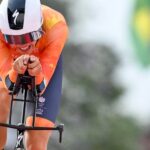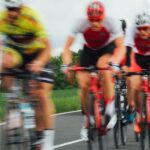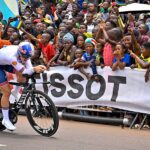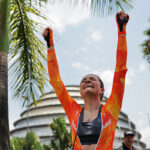I met Nick on a dating app, and our first date was a bike ride. We pedaled to a river and sat on a rock by the water. He asked me lots of questions and listened thoughtfully to the answers. He was cute and sincere, and we had a lovely afternoon.
After that, we met most weeks for bike excursions or dinners. Nick rides an old Surly Straggler which is probably a size too small for him. But he pushes it to its full capacity, logging thousands of hard, fast miles each year in Colorado’s thin mountain air. I’m a more whimsical rider, plodding along however the spirit takes me — slow but happy in any kind of weather. Somehow we found a rhythm that worked for us both.
There was only one problem: Nick didn’t camp. I found out a couple weeks after we met. “Oh, I’ve been camping,” he said. “Maybe a few years ago?”
Something about me: I basically live outside. I’ve built my life around long journeys, and I often work from a portable keyboard in my tent. I knew that if we wanted to continue the relationship, we’d have to enjoy camping together. So a few days later, I floated the idea of a bikepacking trip. Nick said it was something he’d always wanted to try. We pulled up our calendars and found a few days in March when we could both get away. I was delighted — we were going on an adventure.
As I learned while planning, outfitting, and embarking on a trip with a new partner, there’s a right way and a wrong way to take someone on their first bikepacking excursion. And while what follows is mostly the wrong way, no one died and we had a great time. Here’s how I did it so you can learn from my successes and my failures.
Route Planning
I poked around the usual route-planning websites: Adventure Cycling, Bikepacking.com, and Bikepacking Roots. I’d recently done a fun overnight on Adventure Cycling’s Great Parks South route, a paved ride that starts just a few miles from where I lived in Durango, Colorado. This time, however, I thought a gravel route at a lower, warmer elevation would be a better fit for us and our bikes.
I found a few different options and whittled them down to a favorite: Utah’s Grand Staircase Loop. It looked beautiful, the seasonal riding window aligned with our schedule, it was relatively close, and we could do it with the bikes we already had. Unfortunately, it wasn’t a beginner route, and there was only one water source for 160 miles.

I hemmed and hawed. I read and re-read the route commentary, searching for clues about other water sources and the terrain’s true difficulty. Everything I read made it seem dry, remote, and logistically tricky — not at all what I’d choose for someone who’d never been bikepacking before. Especially if I wanted them to like me afterwards.
But I’d seen Nick stride up slopes in freezing weather, bomb down gnarly hills, and meticulously plan his layers and snacks. He was strong, knew his bike inside and out, and never complained. I had a feeling he’d be up for a real adventure, so for better or worse, we set our sights on Utah.
Everything I read made the route seem dry, remote, and logistically tricky — not at all what I’d choose for someone who’d never been bikepacking before. Especially if I wanted them to like me afterwards.
Bikes
I’d bring my Kona Sutra ULTD and Nick would take his Straggler. His bike was sturdy enough for the ride, but I asked if he’d be willing to change his tires to tubeless. We’d be in a remote desert with a lot of logistical unknowns, so I wanted to mitigate the risk of mechanical issues.
The Straggler’s tubeless tires were still slightly narrower than ideal, but Nick and I talked about it and agreed that they’d work for our goals. I knew Nick was good at handling his bike in a variety of conditions, and if the terrain was really bad we could always hike-a-bike.
We’d be in a remote desert with a lot of logistical unknowns, so I wanted to mitigate the risk of mechanical issues.
Gear and Packing
Nick didn’t have any bikepacking gear, but that didn’t strike me as a problem. I have a long history of splicing random things into “oddly functional” gear. (See A Coworkers Campout or Packing Hacks for an Inexpensive Tour for an eclectic array of DIY options.)
In recent years, I’ve also had the great fortune to test new gear from awesome brands like Revelate Designs, Old Man Mountain, Big Agnes, and Showers Pass. This meant that I had a whole box of extra cycling and camping gear.

The week before our trip, I dumped the box out on the floor and sorted through my options. I’d given Nick a list of clothing to bring from home, so I needed to piece together everything else: camping gear, cooking necessities, food, and bags. It was a bit of a puzzle, but eventually I formed a large pile of everything we needed. The gear didn’t have to be perfect — it just had to keep us safe enough to survive the elements and comfortable enough to have a good time doing it.
The gear didn’t have to be perfect — it just had to keep us safe.
Safety First
A few days before we left, I still couldn’t confirm any additional water sources, and we were on a tight schedule with no margin for delays. So we decided to tweak our plans and spend the first couple nights car camping in the desert outside Durango. Then, we’d drive to Utah and bikepack a section of the Grand Staircase route instead of the whole thing.
The last-minute change was a little disappointing, but from a safety perspective, I’m very glad we made it. Sometimes people think that adventure means taking a lot of risks. I think the best adventures happen when you manage risk in safe ways and really enjoy the experience.
The best adventures happen when you manage risk in safe ways and really enjoy the experience.
The Real vs the Ideal
One thing I often remind myself is: There are ideal situations, and then there are real situations. In an ideal situation, I’d plan the perfect route, bikes, and gear to match. I’d print out a gear list with little checkboxes and check them off well in advance. And I’d take any beginning bikepacker on an easy trip before trying something harder.
But in this real situation involving two people scrambling to plan a ride in the midst of a thousand other life circumstances, I narrowed things down to the most basic levels of functionality, motivation, and safety. We used the bikes and gear we had. We chose a route that was easy to access and beautiful enough to motivate the journey. And we switched up our plans last minute to account for unknown variables. It wasn’t ideal, but it still worked in reality.
I narrowed things down to the most basic levels of functionality, motivation, and safety. It wasn’t ideal, but it still worked.
The Actual Trip
On an afternoon in late March, we drove to a backcountry campsite and pitched our tent. Soon the wind picked up, whipping streams of sand against our faces. We ate dinner crouched behind the car, and then crammed ourselves into my tiny, one-person tent.
Throughout the night, the wind bashed our shelter in all directions, forcing sand and dust under the fly. At dawn I woke up and turned to Nick. His face and sleeping bag were covered in a thick film of grit. I felt oddly gleeful. Usually, I make bad decisions all by myself, but now I had Nick to make bad decisions with me! Things were already going well.

We spent another day at the campsite, and then drove to Utah and got a motel room. The next morning, we rolled our loaded bikes out the door, high fived in the parking lot, and pedaled out of town on a dirt road that headed straight into the desert. Our plan was to bike about 40 miles and camp by a lake, which was our only water source. This route would include a 1,500-foot climb and possibly rocky terrain.
I hadn’t meant for this to be a test, but he was passing.
Soon, the desert morphed into masses of boulders and cliffs. Nick powered up the hills and seemed elated as the route steepened. Finally, we zigzagged up a long ridge and looked out over a swathe of epic red canyons. It was one of the most beautiful rides I’d ever done.
After a lunch break, we headed down to the lake, but when we got there, all we found was dried mud. We hopped off the bikes and pushed them across the dried lakebed. I began to feel guilty about everything I’d put Nick through. He, however, was remarkably resilient. I hadn’t meant for this to be a test, but he was passing.
About half an hour later, we spotted a shimmer of wet mud, then a trickle of water, and eventually, a clear pool. Birds flew overhead and a fish jumped. We were saved. We pitched the tent on a crusty patch of mud. I filtered water and Nick gathered wood. As the sun set, we lit a fire and watched the sky deepen into starlight. We were dirty and tired. Nothing had gone perfectly, but still, it was a perfect evening.
The post How to Take Your Date on Their First Bikepacking Trip appeared first on Adventure Cycling Association.




